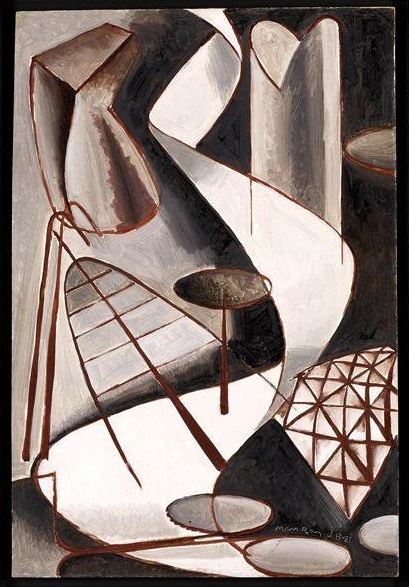Tags
20th century art, 391 magazine, avant-garde, Catherine Deneuve, Centre Pompidou, Dada, Dmitry Shubin, earrings, Francis Picabia, GianCarlo Montebello, Jacques Faujour, Jean Cocteau, jewellery, lampshade, Lèvres d'Or, Man Ray, Pierre Restany, Retour à la Raison, Return to Reason, short film, spiral, Surrealism, The Sunday Times Magazine, Tristan Tzara
American visual artist Man Ray (born Emmanuel Radnitzky, sometimes spelled Rudnitsky, 1890–1976), was a leading figure of the Dada art movement, and later of Surrealism, in both New York and Paris. He worked in several media exploring the concept of the ‘found object’ – treating discarded materials as valued artifacts. Many of these objects recur over many years in a range of the artist’s work.
The spiral motif
The motif of the unwinding swath of paper first appeared in Man Ray’s controversial Dada sculpture of 1919, Lampshade, in which an unrolled paper lampshade curled around a metal shaft (see below). He returned to the spiral motif in a few subsequent works, three of which are titled Return to Reason (or Retour à la Raison): a 1921 painting, a short film made in 1923, and a larger version of the painting, executed in 1939.

Man Ray, Lampshade, 1919 | Photo by Man Ray
This photograph was published in Spanish / French literary magazine 391, nº 13, July 1920, beside, among others, the following text (English translation underneath):
La connaissance et la morale ne sont que papier à mouches, je conseille aux mouches de vivre dans les confessionnaux, les pêchés étant une nourriture bien plus agréable que le caca.
Knowledge and morality aren’t but flypaper, I advise flies to live in confessionals, for sins are much more pleasant nourishment than shit.*
— Francis Picabia, French poet and painter (1879–1953)

Photo by Man Ray, 1924

Photo by Man Ray, 1924
Romanian-French poet, essayist and performance artist Tristan Tzara (1896–1963, left), and French author and designer Jean Cocteau (1889–1963), photographed by Man Ray in 1924.

© Man Ray Trust / ARS-ADAGP
Man Ray
Return to Reason
1921
Oil on board, 37.1 x 25.1 cm

© Museum Ludwig, Köln
Man Ray
Lampshade
circa 1964
Paper spiral mobile

Photo by Jacques Faujour, 1977 | © Bibliothèque Kandinsky / MNAM-CCI / Centre Pompidou
Works by Man Ray and other visual artists in the temporary exhibition Paris-New York, 1908-1968 at the Centre Pompidou, Paris, 1977. Man Ray’s lampshade can be seen hanging from the ceiling near the centre of the photo.

© Archives Artcurial
A pair of 18K yellow gold spiral ear pendants, titled Pendants Pending, designed by Man Ray, and created by goldsmith GianCarlo Montebello in 1970. This pair was auctioned by Parisian auction house Artcurial in 2014. Estimated at € 18,000 to € 20,000, the earrings ultimately fetched € 57,600.
Les bijoux d’artiste sont le témoignage émouvant de la rencontre entre deux styles, celui de l’artiste et celui de l’orfèvre.
Jewellery designed by artists bears touching testament to an encounter between two styles – that of the artist, and that of the goldsmith.*
— Pierre Restany, French art critic and philosopher (1930–2003)
Around 1968 Man Ray had already made a pair of these earrings, which became famous after French actress Catherine Deneuve wore them in a series of portraits shot by Man Ray (see below). The earrings were only taken into production in 1970 with the help of Milanese goldsmith and jewellery designer GianCarlo Montebello.
Because of the pendants’ weight, a special mechanism was created that allows them to be placed around the ears instead of hung from the earlobe as traditional earrings.

Photo by Man Ray, 1968 | © Man Ray Trust / ARS-ADAGP / DACS
Catherine Deneuve wearing the gold spiral ear pendants. This photo by Man Ray appeared on the cover of the June 16th, 1968 issue of The Sunday Times Magazine (UK) with the subtitle ‘The Mysterious Art of Catherine Deneuve.’

Photo by Man Ray, 1968 | © Man Ray Trust / ARS-ADAGP / DACS
Deneuve is surrounded by objects made by Man Ray, including a painted room screen, a paper spiral mobile, the gold earrings echoing the spiral motif, a chessboard table, six carpenter’s planes, and a jewellery box disguised as a book with the title Lèvres d’Or (‘Lips of Gold’).

Photo by Man Ray, 1968 | © Man Ray Trust / ARS-ADAGP / DACS
Retour à la Raison / Return to Reason
An experimental film by Man Ray, 1923
Duration: 00:02:54
Soundtrack (2015) by YouTube user r0ygbiv24
Man Ray made this short movie, one of the first Dadaïst films, by placing objects over pieces of film inside a darkroom and then turning the lights on to print the shadows of the objects onto the film.
The short film contained no audio track originally; the soundscape heard in the video below was added by the person who uploaded it to YouTube in 2015. So if you want a totally authentic viewing experience, you’ll have to mute the sound.
Tasio Ferrand © December 7, 2017
* Quotes translated by Tasio Ferrand.
Sources:
https://collections.artsmia.org/art/5035/return-to-reason-man-ray
http://gallica.bnf.fr/ark:/12148/bpt6k891104w/f11.image
https://en.wikipedia.org/wiki/Man_Ray
http://catalogueexpositions.referata.com/wiki/Paris-New_York
http://www.artcurial.com/en/asp/fullCatalogue.asp?salelot=2613+++++222+&refno=10512353 http://www.arterritory.com/en/texts/interviews/5772-the_conductor_of_an_orchestra_of_artist_jewellery/
https://www.amazon.com.mx/Man-Ray-Portraits-Terence-Pepper/dp/1855144433
http://www.imdb.com/title/tt0014406/
https://www.youtube.com/watch?v=0PNWJsr7hOU
